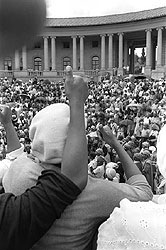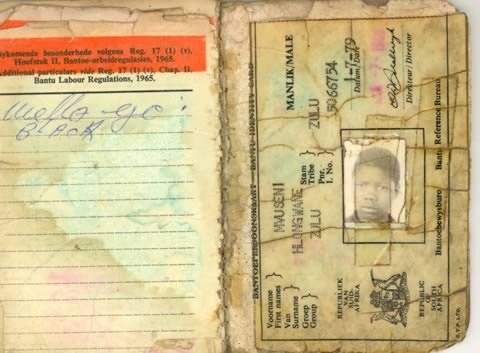1948: The National Party Victory
South Africa, 1948: the United Party (led by incumbent Prime Minister Jan Smuts) and the Herenigde Nasionale Party (Reunited National Party) (led by DF Malan), competed against each other in the national elections. This was an election where only white South Africans could vote, and realising that many of the electorate felt threatened by black political and economic aspirations, Malan promised a system of grand Apartheid if he was victorious.
The HNP was victorious and when they came into power in 1948, they implemented Apartheid. The HNP was eventually renamed the National Party and thus, the same party was in power from 1948 to 1994, when the African National Congress took power in the first democratic elections in South Africa that featured universal franchise.
1950: The Group Areas Act
One of the first acts to be enacted following the implementation of Apartheid was the 1950 Group Areas Act. The Group Areas Act divided up urban areas and assigned different racial groups to different residential and business areas. This meant that the black, white, Indian and coloured populations could not live together or own businesses in the same areas. The 1913 Native’s Land Act had already ruled that only white people could become landowners in South Africa.
1952: The Pass Laws
The 1923 Native Urban Areas Act had made it compulsory for black men in cities to carry passes on them. Any man found without a pass would be arrested and sent to a rural areas. In 1952, the Native Laws Amendment Act and the Natives (Abolition of Passes and Coordination of Documents) Act were enacted to assist in policing the 1950 Group Areas Act. The Native Laws Amendment Act required that no black South African could remain in an urban areas for longer than 72 without the necessary documentation. The Natives (Abolition of Passes and Coordination of Documents) Act required that all black South African men over the age of 16 had to carry a single reference book. It also noted that women would be required to carry such reference books at some time in the future.
The Injustice of the Dompas
The reference book (enduringly referred to as the dompas in Afrikaans) would stipulate where and for how long a person could remain and it included photographs, fingerprints and employer details. It was a horrifically limiting document because black South Africans were subject to persecution if they were found to be outside of their stipulated area. That meant that a man could not visit his brother who was working in the next neighbourhood, for instance. If he lost his job, his right to remain in an urban area could be rescinded by any government employee and he could be made to return to rural areas immediately.
Blacks in urban areas were often forced to leave their families behind in rural areas. The consequence of this is that they could be subject to arrest, punishment and persecution if they were discovered to be travelling to or from those rural areas too. Basically, each time a black person wanted to move within the country, they had to seek permission and that permission was recorded in their pass book.
Life in the Homelands
In the decades leading up to the 1950s, the majority of black South Africans in urban areas had been men. They were often migrant workers, employed on mines and in factories and women were often left behind to look after the family. The problem with the rural areas (and Homelands) allocated to black people is that they were specifically chosen on the basis of their dry, arid and unsustainable nature. The very worst pockets of land in South Africa were allocated to rural black populations.
A combination of factors lead to more and more women moving to urban areas in the early days of Apartheid. Some scenarios include the death of income earners in precarious conditions in mines and factories; neglect from partners who took up with mistresses in town; and severe poverty caused by the high cost of living in urban areas, the inability to send enough money home, and the inability to sustain families in the arid conditions of the Homelands and rural areas. Women were also permitted to join their spouses in urban areas if he had been born in that area or had laboured continuously in an area for over ten years.
(Incidentally, many of these factors continue today and many children are brought up in rural areas by grandparents and the extended family as poverty and economic needs continues to drive families apart).
1955: Plan to Issue Pass Books to Women
In response to the growing number of black women in urban areas, the government announced in September 1955 that all black women would be issued reference books with effect from January 1956.
9 August 1956
 ©Baileys Archives [Source] | The protest on 9 August 1956 was not the first protest against the Pass Laws and it was one action among one of the most colourful and successful liberation struggles in history. What was outstanding about this protest is that it surprised many parties, the government and liberation movement included and it showed that women were active, organised and militant. |
On 9 August 1956, 20,000 women marched to the Union Buildings in Pretoria in protest of the pass laws and the roll out of reference books for women. The march was organised by the Federation of South African Women in conjunction with the ANC Women’s League and was attended by such great women as Helen Joseph and Albertina Sisulu.
Women came from all over the country to attend the protest, from as far afield as Durban and Cape Town, and black, white, coloured and Indian women attended the march.
The crowd left bundles of petitions filled with 100,000 signatures at Prime Minister JG Strijdom’s doors as he was not at the Union Buildings that day.
In a masterpiece of peaceful protest, the women stood for a full half an hours’ silence, many with children on their backs, as they protested the assault on their freedom and integrity that the pass laws represented.
9 August 1994
Apartheid ended in 1994 when the African National Congress came to power. Since 9 August 1994, the day has been commemorated as National Women’s Day in South Africa. It is a public holiday and that is why South Africans celebrate women’s day on a different day to the rest of the international community.



2 comments
It can be so sad reading how times used to be and how there were discrimitive to others. Loved the pictures you used. Thanks for a wonderful recap of history :-)
Thanks for reading Tina! It was hard growing up in South Africa where racism, hatred and discrimination was the norm. I have to say, in light of my life experience, that the open and unchallenged racism and discrimination in the UK terrifies me.
Post a Comment